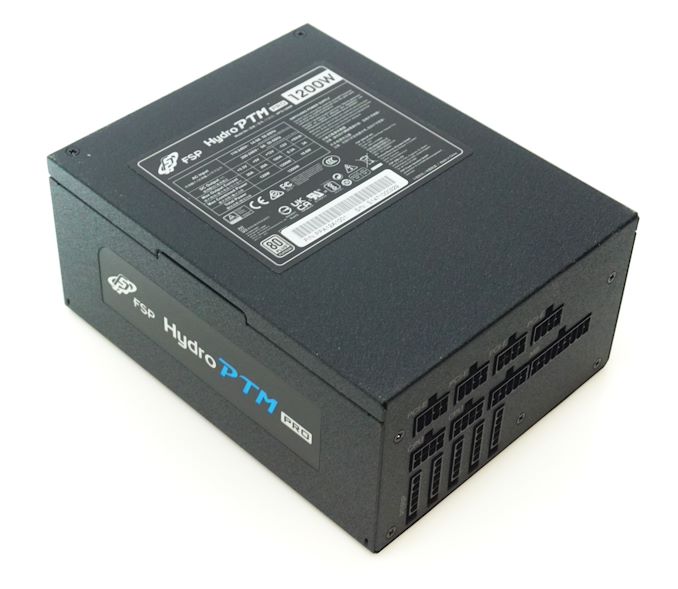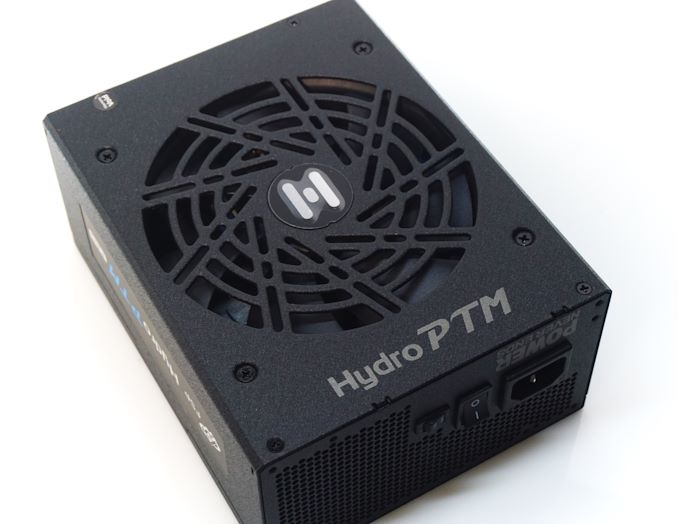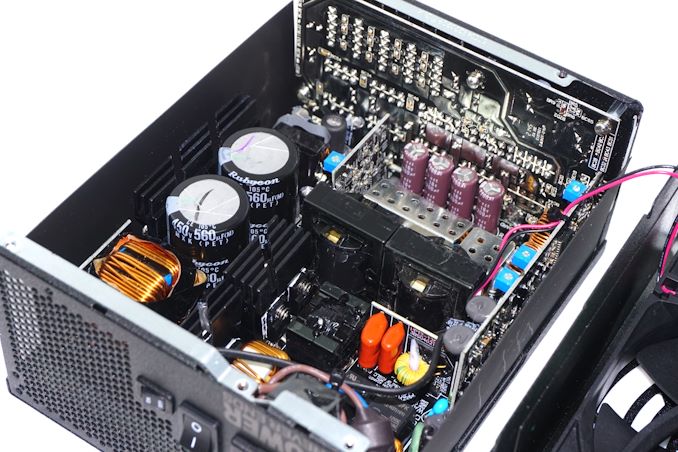The FSP Hydro PTM Pro 1200W PSU Review: Improving on the Tried and True
by E. Fylladitakis on April 20, 2022 8:30 AM EST- Posted in
- Cases/Cooling/PSUs
- PSUs
- 1200W
- FSP
- 80Plus Platinum
- Modular
Power Supply Quality
As part of our testing, we also check output parameters are within specifications, as well as voltage ripple and line noise.
| Main Output | ||||||||
| Load (Watts) | 243.15 W | 607.24 W | 904.47 W | 1202.96 W | ||||
| Load (Percent) | 20.26% | 50.6% | 75.37% | 100.25% | ||||
| Amperes | Volts | Amperes | Volts | Amperes | Volts | Amperes | Volts | |
| 3.3 V | 1.87 | 3.44 | 4.68 | 3.42 | 7.01 | 3.4 | 9.35 | 3.38 |
| 5 V | 1.87 | 5.12 | 4.68 | 5.11 | 7.01 | 5.04 | 9.35 | 5.04 |
| 12 V | 18.71 | 12.14 | 46.77 | 12.13 | 70.15 | 12.05 | 93.53 | 12.02 |
| Line | Regulation (20% to 100% load) |
Voltage Ripple (mV) | |||||
| 20% Load | 50% Load | 75% Load | 100% Load | CL1 12V |
CL2 3.3V + 5V |
||
| 3.3V | 1.7% | 12 | 16 | 20 | 28 | 14 | 16 |
| 5V | 1.5% | 10 | 10 | 12 | 16 | 8 | 12 |
| 12V | 1% | 12 | 16 | 18 | 20 | 20 | 16 |
The electrical performance of the FSP Hydro PTM Pro 1200W PSU is excellent overall. Our instruments recorded a maximum ripple of 20 mV on the 12V line, a mere sixth of the 120 mV recommended design limit and an outstanding figure for a PSU with that kind of power output.
The filtering on the 3.3V and 5V lines is good, with a maximum of 28 mV and 16 mV on the 3.3V and 5V lines respectively. The unusual part here is that the filtering on the 5V line is significantly better than that of the 3.3V line, which is a reasonable design choice considering that the 3.3V line is barely used anymore, but it is not a typical design practice. Voltage regulation is very good on the 12V, holding at 1.0% across the nominal load range. The regulation of the 3.3V and 5V lines is slightly inferior, at about 1.6% across the load range.
Conclusion
FSP developed the Hydro PTM Pro as a successor to the Aurum PT, in an effort to compete with the newer, more advanced PSU platforms from other manufacturers. The 1200W unit that we tested today is the most powerful of the series but the company also has 1000W and 850W versions of the same platform available – all of which are just as large too. FSP also is the OEM behind the creation of the platform, therefore we expect to see the same base design filter down into other products as well.
It can be said without a doubt that FSP focused most of their design and marketing efforts on quality. Both externally and internally, the Hydro PTM Pro is built like a tank. FSP did not cut any corners and used only top-quality parts for the creation of the Hydro PTM Pro, down to secondary circuitry and components. This, of course, includes the cooling fan - the Protechnic Electric is a rare sight in commercial PSUs for a reason, and that reason is its very high cost. The assembly job is outstanding, with a very clean layout and every part that could be somehow dislodged glued down. Even its paint is very difficult to scratch, as if the designer was expecting the PSU to be installed in a moving contraption. FSP covers the Hydro PTM Pro with a ten-year long warranty, among the longest in the market at this time.
The overall performance of the Hydro PTM Pro is very good but, honestly, we expected a bit more, especially from a company whose platform releases are few and far between. The Hydro PTM Pro is not significantly better than its predecessor, the Aurum PT, which was first released nearly a decade ago. It does offer substantially better power quality and it runs cool but, compared to its predecessor, its energy conversion efficiency practically remains about the same and sustains the same massive external proportions. We cannot help but feel that FSP could have done better by either reducing the length of the unit or improving its overall efficiency, although we have to admit that getting an efficiency certification above 80Plus Platinum is a tremendously challenging task.
In summary, the Hydro PTM Pro is meant to be an upgrade of the Aurum PT, yet few things have changed. The power quality of the Hydro PTM Pro undeniably is better and the unit runs cooler but, on the other hand, it retains its long chassis, is about just as efficient as its predecessor was, and can be pretty loud when stressed. It currently retails for about $270, which pits it directly against some significant and very capable competition. Regardless, the Hydro PTM Pro 1200W PSU unquestionably is a very good product that can easily become attractive if the retail price drops during a sale.













20 Comments
View All Comments
Xpl1c1t - Wednesday, April 20, 2022 - link
1.2kW supply with capacity for 5x pcie power cables.Lets call this out, its for mining rigs.
For the rest of us using 150-250watt GPUs and 100-150w CPUs, a 450-600w PSU with platinum rating would be welcome addition to the rig, especially for the idle/web-browsing low power efficiency. As a general rule, given a platinum rating, the lower wattage unit will have much better efficiency in the 40-80w region that most of our desktop rigs sit at for most of the day.
My 5800x and 1080 GTX are made amazingly more efficient in light duty computing by my Prime Fanless 450w supply.
bananaX - Wednesday, April 20, 2022 - link
Sorry, your comment is wrong on many levels.#1 it has 4 pcie- connectors, which means 4 usable cables(that split into 8)
#2 for 1.2KW that is bad for miners, the 1200W from EVGA has 6
#3 the GPU in my desktop has used more than 250W a long while now :).
Xpl1c1t - Wednesday, April 20, 2022 - link
1) You're right, i guess i've gotten too spoiled by the fact that my Seasonic unit doesnt discriminate between CPU and PCIe connectors at the power supply, Both cables are interoperable in the same plug, which is excellent design imo.2) The cables included with the unit are daisy chained with two 6+2 ends per cable, thats a potential total of 8 cards drawing 75w per from the mobo and 75w per from the pcie cable. Thats 150w per card which is your typical draw after underclocking and undervolting for mining purposes.
3) Well arent you special.
Jp7188 - Tuesday, May 3, 2022 - link
I'll just chime in and say i consider 1200 as a minimum and currently run an axi1500. my rig has an evga 3090 hybrid with a 500w power limit in bios. It runs at that limit often. The 12900k cpu is overclocked and routine runs over 300w and is only held back by thermal throttling. Thats 800 before we talk mb, fans, water pumps, drives, etc. ... and I like to have some good reserves just to make sure any instability while overclocking doesn't result from the PS.ballsystemlord - Wednesday, April 20, 2022 - link
You've missed 2 very important points.Buying above your power requirements for your system means that your PSU runs quieter and should last longer.
Vega 64 was measured by adoredtv (at the wall) and was estimated at drawing 400W https://youtu.be/bIGpvBrwXvA. That's 1/3rd of this PSU's output. With a CPU like Threadripper, you'd draw another 280W. Now you're above 1/2 of the PSU's output.
Then you add in ~220W for a 5m RGB light strip, 30W (a PC repair guy quoted this to me years ago as an HDDs start up power) * 4 for RAID10 HDDs, how about 60W for a Motherboard + 4 RAM sticks (just to be safe, IDK how much actual MBs and RAM draw), and finally 20W for 2 SSDs (that's about what some PCIe4 SSDs were drawing).
Then you're using 1,100W! You have just 100W of leeway for aging and sudden power draw.
Now what would happen if we added in a second GPU for SLI/Crossfire?
Now do you understand who this is designed for? It's for those with powerful PCs.
Xpl1c1t - Thursday, April 21, 2022 - link
220w RGB strip? Thats on the order of putting a high output grow light in your rig. I imagine you meant 20w?Point stands that the lower the unit wattage at a given 80+ rating, the generally massively superior efficiency performance you will find during low-power computing & system idle.
ballsystemlord - Thursday, April 21, 2022 - link
0.02A per LED. 3 bulbs for RGB. Running at 12v (or so I've read). 60 LEDs per meter. 5 meters.0.02*3*12*60*5 == ~220w
SodaAnt - Thursday, April 21, 2022 - link
That's an insane amount of power. A normal LED bulb for a light fixture uses ~8W. 220W would be basically your PC blasting out insane amounts of light brighter than a car's headlights. A typical PC RGB setup uses maybe 5-10W.ballsystemlord - Thursday, April 21, 2022 - link
There are more efficient RBG LEDs out there.Calin - Thursday, April 21, 2022 - link
"30W for the HDD" - this might be ramp-up power, necessary for a short while. I remember an old server mainboard with SCSI had in BIOS the option to start the hard drives "staggered" by several seconds each, to spread the "ramp up" power.However, the HDD ramp up will usually take place at startup, when there's little GPU load.
And SLI/Crossfire is inferior to a single big card. I'm not sure you would need it with a 400W GPU.